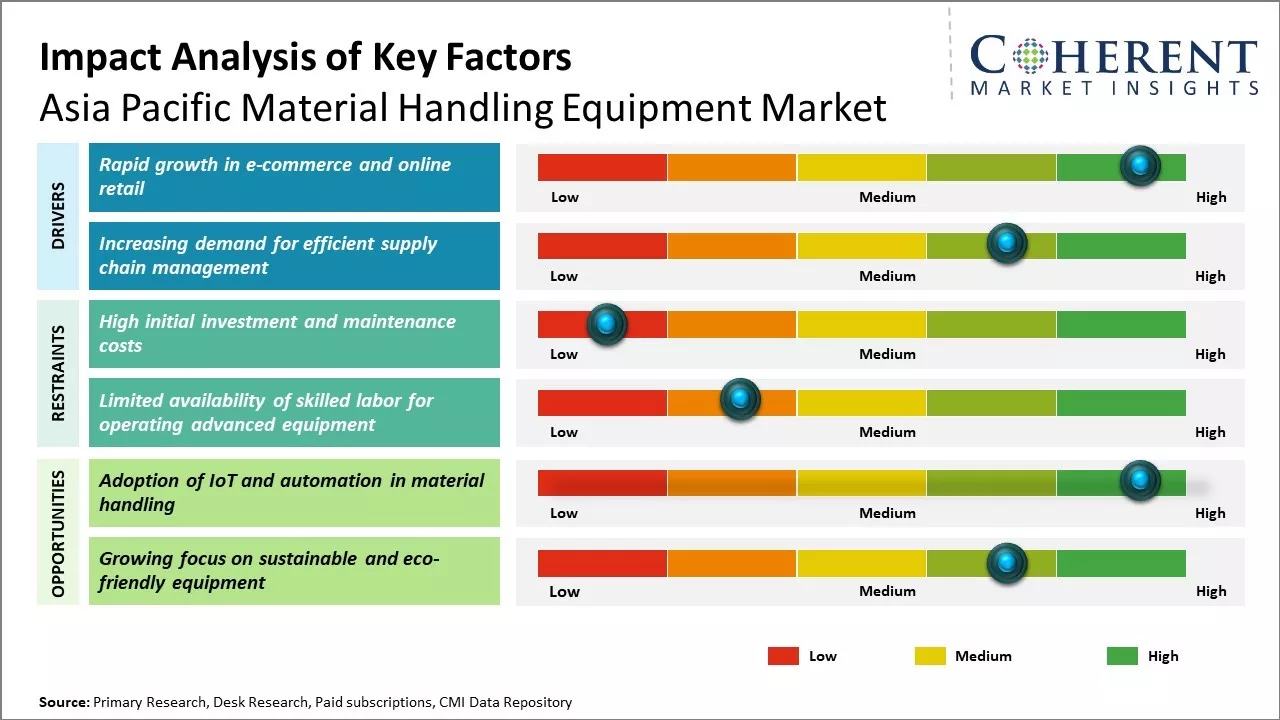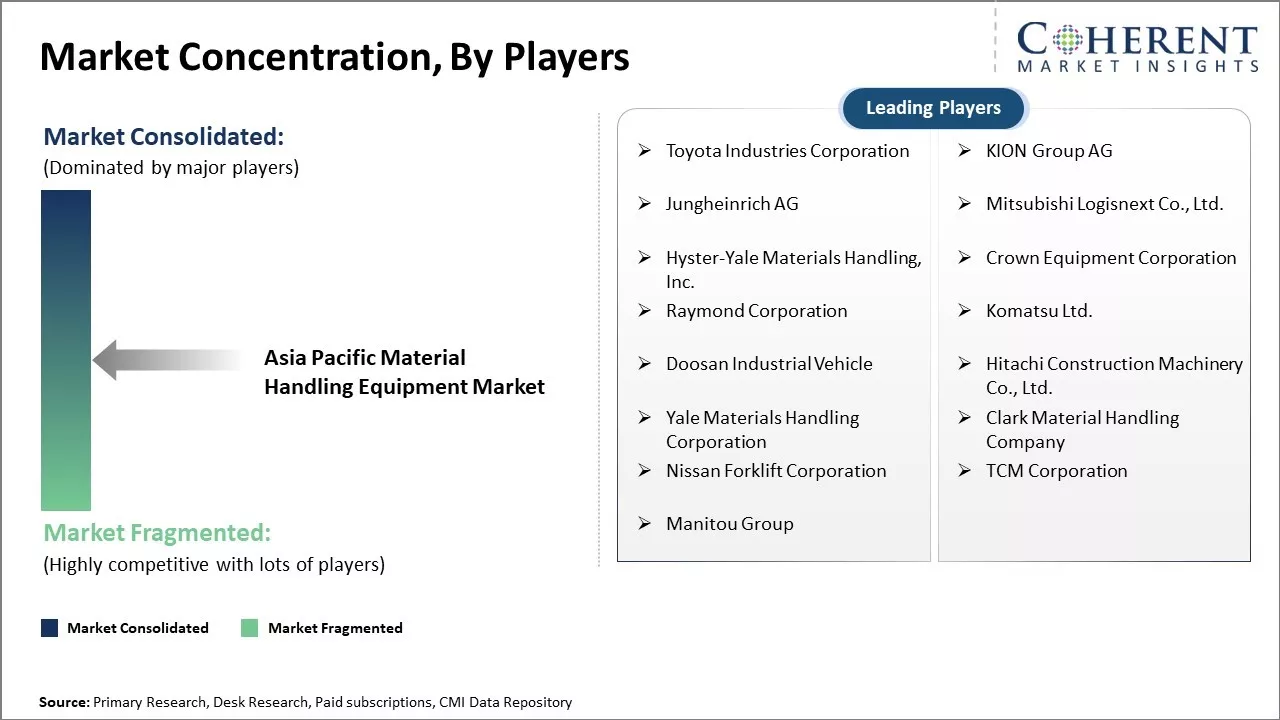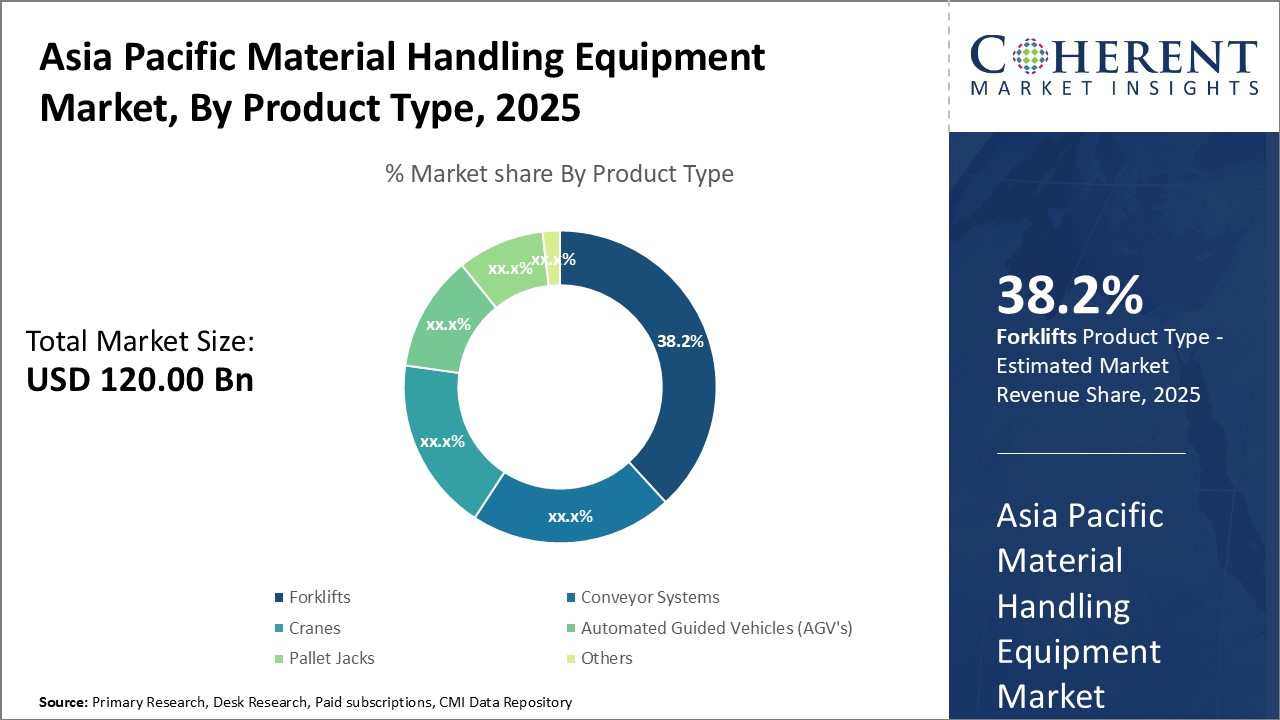Asia Pacific Material Handling Equipment Market Size and Trends
The Asia Pacific material handling equipment market is estimated to be valued at US$ 120.00 Bn in 2025 and is expected to reach US$ 189.06 Bn by 2032, exhibiting a compound annual growth rate (CAGR) of 6.7% from 2025 to 2032.

Discover market dynamics shaping the industry: Download Free Sample
Rapid industrialization and growth of the e-commerce industry have been major factors driving increased demand for material handling equipment in the Asia Pacific. The Asia Pacific Material Handling Equipment Market has been witnessing considerable growth over the years owing to expansion of warehousing facilities by major third-party logistics companies and growth in investments towards automation by key industries such as the automotive, food & beverage, and semiconductor industries. Increasing focus on operational efficiency and productivity improvements have propelled the adoption of modern material handling solutions across Asia Pacific. Four types of material handling equipment used in the industry are storage and handling equipment, industrial trucks, engineered systems, and bulk material handling equipment.
Market Driver - Rapid growth in e-commerce and online retail
The Asia Pacific region has seen tremendous growth in the e-commerce sector over the past decade. Expanding internet penetration coupled with rise of smartphone usage has enabled more consumers to shop online for various goods ranging from apparel to electronics. Countries like China, India, and Indonesia especially have emerged as lucrative markets for e-commerce companies. The COVID-19 pandemic has further accelerated this shift to online shopping as more people turned to websites and apps for procuring items while avoiding crowded public areas.
This boom in e-commerce has significantly increased the need for material handling equipment across warehouse and fulfillment centers of various retailers and logistics companies. Sophisticated automation systems are required to efficiently receive, process and dispatch a huge volume of smaller orders on daily basis. E-commerce giants such as Alibaba, Shopee, Lazada, Rakuten, Tokopedia, AliExpress, BliBli, etc. make substantial investments to upgrade their inventory management and order picking capabilities through adoption of latest generation conveyor belts, automated storage and retrieval systems, sortation systems, and robotic arms. Cross-docking facilities also integrate automated sorting lines and carousels to quick transfer shipments between trucks and trailers for last mile delivery.
Rise of demand from tier 2 and tier 3 cities in developing countries also propels the need for scaling up logistics infrastructure. Third-party logistics firms open many new distribution centers to cater orders from rural areas, requiring installation of various material handling machinery. Rapid inventory turnover demands optimal utilization of warehouse floor space through mechanical handling of products as opposed to manual labor intensive processes. Furthermore, consumer expectation of fast delivery within few days encourages supply chain players to invest in mechanization for boosting operational efficiency.
Market Concentration and Competitive Landscape

Get actionable strategies to beat competition: Download Free Sample
Increasing demand for efficient supply chain management
In the current competitive business environment, companies are under constant pressure to deliver orders to customers in the shortest possible timelines. This emphasizes the need to streamline internal supply chain operations and curb operational expenses. Material handling equipment plays a pivotal role in automating key supply chain functions and facilitating just-in-time manufacturing and distribution processes.
Omnichannel retailing strategies followed by many retailers and brands also necessitate advanced integration between physical and online order fulfillment channels. Seamless flow of inventory across different warehouse locations and distribution of multi-channel orders require sophisticated material handling automation controlled through warehouse management systems. Moreover, unpredictable demand patterns amplified during pandemic highlights the importance of flexible, scalable warehousing facilitated by automated equipment like automatic guided vehicles and shuttles.
On the manufacturing front, industries strive to achieve lean production goals through adoption of Industry 4.0 technologies. Material movement within factories is predominantly automated using overhead conveyors, robotic arms, automated rack systems to support one-piece flow production of high-mix low or medium volume customized product lines. Automated intra-logistics ensure timely availability of components at each work station while eliminating manual material transport delays. This significantly enhances productivity, quality and flexibility of manufacturing operations.
Lean inventory philosophy pursued by supply chain players to avoid stock-outs without overstocking also warrants optimum space utilization. Automatic storage and retrieval systems enable high-density warehousing of components and finished goods. Overall, efficient material flow management from source to delivery remains indispensable for companies to achieve competitive supply chain capabilities and customer fulfillment objectives in the long run.
Key Takeaways from Analyst:
The Asia Pacific region represents a lucrative market for material handling equipment given the strong economic growth witnessed across several nations. Countries such as China, India, Australia, and others present significant opportunities for demand generation. Urbanization and industrialization continue to be the major drivers propelling the need for automation across the manufacturing and warehousing sectors. Additionally, growing e-commerce markets have amplified the requirement for efficient order fulfillment solutions. The manufacturing sector remains the dominant end user and is likely to augment its usage of automated systems to streamline internal processes. While high initial investments associated with automation solutions pose a challenge, cost reductions achieved through scale could help overcome this restraint. Material handling robotics and software are anticipated to gain higher traction in the upcoming years leveraging Industry 4.0 trends. Shorter replacement cycles for aged equipment also contribute to refresh higher spending. Public infrastructure projects across Asia Pacific nations would further stimulate demand. While China dominated the market in the past, other developing economies are witnessing accelerated growth. Thailand and Vietnam have emerged as promising manufacturing hubs attracting foreign investments. The mining sector is also boosting demand substantially especially in Australia and Indonesia. Overall, the bullish macroeconomic outlook remaining intact makes Asia Pacific remarkably well-positioned for vibrant material handling equipment market growth over the next decade if key opportunities are capitalized.
Market Challenge - High initial investment and maintenance costs
The Asia Pacific material handling equipment market faces considerable challenges in terms of high initial investment and maintenance costs. Material handling equipment, such as conveyors, cranes, forklifts, and automated guided vehicles, require substantial capital expenditures. Furthermore, these machinery contain several movable parts and mechanical components that are susceptible to wear and tear. Regular maintenance, repairs, and replacement of parts add to the total cost of ownership over the lifecycle of the equipment. The tropical climate in many parts of Asia Pacific accelerates equipment degradation. Small and medium enterprises in particular find it difficult to absorb such high upfront and operational expenses. The costs pose a major barrier for modernization and expansion of warehouse equipment and distribution infrastructure. Equipment manufacturers need to explore financing options and develop maintenance contracts to make their solutions more affordable and help customers manage equipment life cycle costs in a predictable manner.
Market Opportunity - Adoption of IoT and Automation for Material Handling
The growing adoption of Internet of Things (IoT) and automation presents significant opportunities for the Asia Pacific material handling equipment market. IoT enables the real-time monitoring of heavy machinery to detect faults and predict breakdowns. This allows predictive maintenance and reduces unexpected downtime. Users can optimize equipment utilization through remote operations and analytics. Integrating automation through robots, autonomous vehicles, and automated storage and retrieval systems can boost productivity and efficiency multifold. It addresses the issues of labor shortage and rising wages in the region. Equipment providers who introduce IoT-enabled and automated solutions will be best positioned to tap into this lucrative opportunity. Standardization of communication protocols and development of technologies such as 5G will further accelerate Industry 4.0 adoption in material handling operations across Asia Pacific. Examples of materials and equipment include raw materials like metals, plastics, and chemicals, as well as finished products, machinery, tools, vehicles, and other items necessary for manufacturing, construction, and other industrial processes.

Discover high revenue pocket segments and roadmap to it: Download Free Sample
Insights By Product Type - Demand for Material Transportation Fuels Forklift's Dominance
In terms of product type, forklifts is expected to contributes 38.2% share of the market in 2025 owing to its indispensable role in material transportation within Asia Pacific's thriving manufacturing sector. Forklifts are widely relied on for moving large or heavy items during production, warehousing, and distribution activities. Their versatility and payload capacity enables the efficient movement of raw materials, work-in-progress inventory, and finished goods throughout large factory floors and storage facilities. Given Asia Pacific's status as a manufacturing powerhouse supplying global value chains, reliable material handling is vital to maintain seamless operations. Forklifts perform this function cost-effectively on a massive scale. Their adoption is further spurred by low original purchase costs relative to other equipment like conveyor systems or cranes. With rapid industrialization continuing across developing nations, the forklift demand from diverse end-use industries remains robust.
For instance, o In March 2023, Toyota Material Handling, a leading manufacturer of forklifts and warehouse equipment, introduced a new line of electric forklifts specifically designed for indoor use. This new series aims to enhance operational efficiency in warehouses by providing emission-free, quiet, and reliable material handling solutions, reflecting Toyota’s commitment to sustainability and innovation in the logistics equipment sector.
Insights By Equipment Type - Manual Equipment Fuels Growth Through Labor Intensive Industries
In terms of equipment type, manual is expected to contributes 43% share of the market in 2025 due to its entrenchment in Asia Pacific's labor-intensive industries. Many small and medium enterprises that form the backbone of national economies have cost-conscious business models relying extensively on human labor. Within their confines, basic manually-operated equipment like pallet jacks or hand trucks suffice while keeping capital expenditures low. As these industries cater to price-sensitive local and regional markets, they emphasize affordable operations over automation. Meanwhile, the agricultural and construction sectors dependent on manual labor also drive the procurement of simple manually-powered material handlers. With Asia Pacific's rising living standards increasing consumption of affordable locally-produced goods, the manual equipment segment is poised for continued uptake across the region's diverse industry spectrum.
Insights By End-use Industry - Warehousing & Distribution Powers Ahead on E-commerce Boom
In terms of end-use industry, warehousing & distribution is expected to contributes 39.9% share of the market in 2025 owing to the e-commerce revolution currently sweeping the Asia Pacific region. Online retail platforms like Alibaba, Shopee, Lazada, JD.com, Tokopedia, BliBli, AliExpress, Qoo10, GoTo, Mudah.my., etc. are proliferating with the growth of internet and smartphone access among vast consumer bases. This has spawned a parallel boom in warehousing and logistics services to store, transport, and deliver rising volumes of purchases. Efficient material handling capabilities are mission-critical in the fast-paced order fulfillment process within modern distribution centers and cargo hubs. To maximize space utilization and labor productivity, facilities incorporate an array of forklifts, conveyor belts, lifts, and cranes. Simultaneously, express delivery firms also augment fleets with specialized automated vehicles to achieve nationwide reach. With e-commerce projected to remain a powerful economic driver, ongoing investments will sustain material handling equipment demand from warehouses and distribution networks across the region.
Market Report Scope
Asia Pacific Material Handling Equipment Market Report Coverage
| Report Coverage | Details | ||
|---|---|---|---|
| Base Year: | 2024 | Market Size in 2025: | USD 120.00 Bn |
| Historical Data for: | 2020 To 2024 | Forecast Period: | 2025 To 2032 |
| Forecast Period 2025 to 2032 CAGR: | 6.7% | 2032 Value Projection: | USD 189.06 Bn |
| Segments covered: |
|
||
| Companies covered: |
Toyota Industries Corporation, KION Group AG, Jungheinrich AG, Mitsubishi Logisnext Co., Ltd., Hyster-Yale Materials Handling, Inc., Crown Equipment Corporation, Raymond Corporation, Komatsu Ltd., Doosan Industrial Vehicle, Hitachi Construction Machinery Co., Ltd., Yale Materials Handling Corporation, Clark Material Handling Company, Nissan Forklift Corporation, TCM Corporation, and Manitou Group |
||
| Growth Drivers: |
|
||
| Restraints & Challenges: |
|
||
Uncover macros and micros vetted on 75+ parameters: Get instant access to report
Asia Pacific Material Handling Equipment Industry News
- In September 2023, Crown Equipment Corporation, one of the world's largest material handling companies known for its innovative lift trucks and automation solutions, launched a new series of Automated Guided Vehicles (AGVs) designed for warehouse automation. This new product line aims to enhance operational efficiency and streamline logistics processes, reflecting the growing demand for automation in the warehousing sector.
- In July 2023, Jungheinrich AG, a leading provider of intralogistics solutions, partnered with a technology company to develop smart warehouse solutions. This collaboration aims to enhance operational efficiency and drive innovation in warehouse automation, aligning with Jungheinrich AG's commitment to creating the warehouse of the future through advanced technology integration.
- In May 2023, KION Group, a leading provider of industrial trucks and supply chain solutions, acquired a software firm to enhance its automation capabilities. This strategic acquisition aims to strengthen KION Group's technological offerings and improve operational efficiencies within its product portfolio, aligning with the company's commitment to advancing digitalization in the logistics sector.
- In March 2023, Daifuku Intralogistics India, a subsidiary of Daifuku Co., Ltd. and a leading manufacturer of automated material handling systems, announced plans to construct a new manufacturing plant to further expand its operations. Scheduled to begin operations in 2024, the new facility is expected to quadruple the company’s production capacity, enabling it to meet the growing demand for intralogistics solutions in the Asia Pacific.
*Definition: The Asia Pacific material handling equipment market consists of companies that manufacture and sell a range of heavy machinery used to transport, lift, store, and package materials within industrial and commercial establishments across the Asia Pacific region. Key types of equipment include conveyors and conveyor systems, cranes, industrial trucks including forklifts, automated storage and retrieval systems, and unit load material handling systems. The market has experienced rapid growth in recent years driven by increasing industrialization, manufacturing activity, and investment in warehouses and distribution centers across developing economies.
Market Segmentation
- Product Type Insights (Revenue, US$ Bn, 2020 - 2032)
-
- Forklifts
- Conveyor Systems
- Cranes
- Automated Guided Vehicles (AGVs)
- Pallet Jacks
- Others
- Equipment Type Insights (Revenue, US$ Bn, 2020 - 2032)
-
- Manual
- Semi-Automatic
- Fully Automatic
- End-use Industry Insights (Revenue, US$ Bn, 2020 - 2032)
-
- Warehousing & Distribution
- Manufacturing
- Retail
- Food & Beverage
- Pharmaceuticals
- Others
- Key Players Insights
- Toyota Industries Corporation
- KION Group AG
- Jungheinrich AG
- Mitsubishi Logisnext Co., Ltd.
- Hyster-Yale Materials Handling, Inc.
- Crown Equipment Corporation
- Raymond Corporation
- Komatsu Ltd.
- Doosan Industrial Vehicle
- Hitachi Construction Machinery Co., Ltd.
- Yale Materials Handling Corporation
- Clark Material Handling Company
- Nissan Forklift Corporation
- TCM Corporation
- Manitou Group
Share
Share
About Author
Ramprasad Bhute is a Senior Research Consultant with over 6 years of experience in market research and business consulting. He manages consulting and market research projects centered on go-to-market strategy, opportunity analysis, competitive landscape, and market size estimation and forecasting. He also advises clients on identifying and targeting absolute opportunities to penetrate untapped markets.
Missing comfort of reading report in your local language? Find your preferred language :
Transform your Strategy with Exclusive Trending Reports :
Frequently Asked Questions
EXISTING CLIENTELE
Joining thousands of companies around the world committed to making the Excellent Business Solutions.
View All Our Clients
